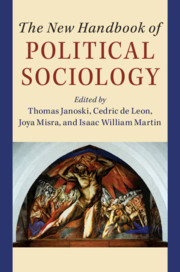Book contents
- The New Handbook of Political Sociology
- The New Handbook of Political Sociology
- Copyright page
- Dedication
- Contents
- Tables
- Figures
- Contributors
- Acknowledgments
- Introduction
- I Theories of Political Sociology
- II Media Explosion, Knowledge as Power, and Demographic Reversals
- III The State and Its Political Organizations
- IV Civil Society: The Roots and Processes of Political Action
- V Established and New State Policies and Innovations
- 30 The Evolution of Fiscal and Monetary Policy
- 31 Welfare State Policies and Their Effects
- 32 Sexuality, Gender, and Social Policy
- 33 Migration, Asylum, Integration, and Citizenship Policy
- 34 Cosmopolitanism and Political Sociology
- 35 War, States, and Political Sociology
- VI Globalization and New and Bigger Sources of Power and Resistance
- Index
- References
31 - Welfare State Policies and Their Effects
from V - Established and New State Policies and Innovations
Published online by Cambridge University Press: 22 February 2020
- The New Handbook of Political Sociology
- The New Handbook of Political Sociology
- Copyright page
- Dedication
- Contents
- Tables
- Figures
- Contributors
- Acknowledgments
- Introduction
- I Theories of Political Sociology
- II Media Explosion, Knowledge as Power, and Demographic Reversals
- III The State and Its Political Organizations
- IV Civil Society: The Roots and Processes of Political Action
- V Established and New State Policies and Innovations
- 30 The Evolution of Fiscal and Monetary Policy
- 31 Welfare State Policies and Their Effects
- 32 Sexuality, Gender, and Social Policy
- 33 Migration, Asylum, Integration, and Citizenship Policy
- 34 Cosmopolitanism and Political Sociology
- 35 War, States, and Political Sociology
- VI Globalization and New and Bigger Sources of Power and Resistance
- Index
- References
Summary
The term “welfare state” reflects the portfolio of social welfare policies and programs within countries. Welfare state scholarship in the early twentieth century focused primarily on sources of welfare state development and expansion. By the turn of the century, the literature shifted toward examining the effects of welfare states, and the policies that compose them, on societal outcomes. Initially, this research examined the effects of welfare states on aggregate levels of poverty and inequality. More recently, as power resource theory and intersectional theory gained traction as important predictors of income and inequality, scholars increasingly turned their attention toward examining the differential effects of welfare states and their constituent policies on inequality between and within subgroups in society, and they expanded the types of outcomes studies, moving beyond income-based measures.
- Type
- Chapter
- Information
- The New Handbook of Political Sociology , pp. 812 - 841Publisher: Cambridge University PressPrint publication year: 2020



